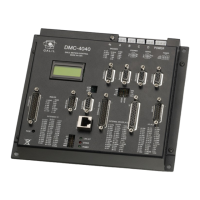TL will limit the output voltage of the ±10V motor command line. This output voltage is either translated into
torque or velocity by the amplifier (Galil's internal amplifiers are in torque mode). This command should be used to
avoid excessive torque or speed when initially setting up a servo system. The user is responsible for determining
the relationship between the motor command line and the amplifier torque/velocity using the documentation of
the motor and/or amplifier.
See the TL setting in the Command Reference for more details.
See the AG command in the command reference for current gains of Galil's internal amplifiers. The amplifier gain
can also be used to change the ratio of outputting amps of the amplifier per commanded volts of the controller.
This is another way to limit the amount of current but can also maintain the resolution of the ±10V motor
command line.
Step B. Set the Error Limit
When ER (error limit) and OE (off-on-error) is set, the controller will automatically shut down the motors when
excess error (|TE| > ER) has occurred. This is an important safety feature during set up as wrong polarity can cause
the motor to run away, see Step C below for more information regarding runaway motors.
NOTE: Off-on-error (OE) requires the amplifier enable signal to be connected from the controller to the amplifier.
This is automatic when using Galil's internal amplifiers, see Step 9. Connecting External Amplifiers and Motors, pg
29 for external amplifiers
Step C. Understanding and Correcting for Runaway Motors
A runaway motor is a condition for which the motor is rotating uncontrollably near it's maximum speed in a single
direction. This is often caused by one of two conditions:
1. The amplifier enable signal is the incorrect logic required by the amplifier
This is only applicable to external amplifiers only.
If the motor is in a MO state when the motor runs away, the MO command is toggling your amplifier
“on/enabled” and needs to be reconfigured. The motor is running away because the controller is registering
the axis is in an “inactive” and is not attempting to control it's movement. See Step 9. Connecting External
Amplifiers and Motors, pg 29 for configuring the amplifier enable signal.
2. The motor and encoder are in opposite polarity causing a positive feedback loop
Reversed polarity is when a positive voltage on the motor command line results in negative movement of the
motor. This will result in a positive feedback loop and a runaway motor.
The following steps can be taken to detect reverse polarity, the A-axis is used as an example:
1. After connecting your servo motor using either Step 8. Wiring Motors to Galil's Internal Amps, pg 22
or Step 9. Connecting External Amplifiers and Motors, pg 29 issue the following commands:
MO A
KIA= 0
KPA= 0
KDA= 0
SH A
2. Check your current position by issuing TP A.
3. Set a small, positive voltage on your motor command line using the OF command; use a high enough
voltage to get the motor to move. This will cause a runaway-like condition so have an appropriate OE
set, see Step B. Example:
OFA= 0.5
4. If the motor has not been disabled by OE, disable it by issuing MO A.
5. Check the position again by using TP A.
Chapter 2 Getting Started ▫ 21 DMC-40x0 User Manual

